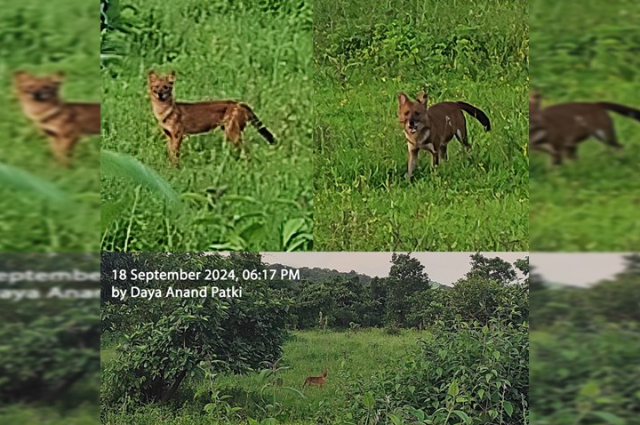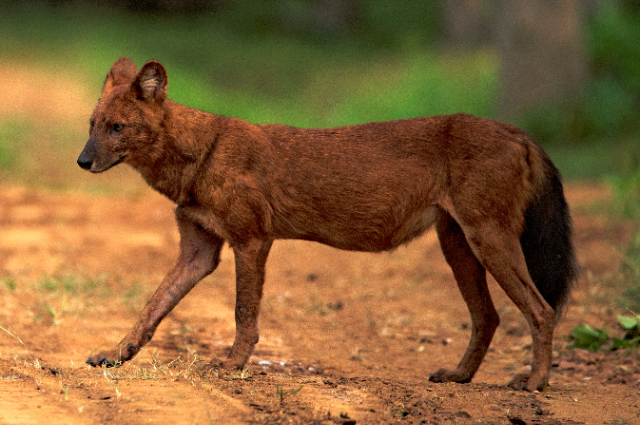
Image by Daya and Anand Patki
In a rare and remarkable sighting, a herd of 10 wild dogs, also known as dholes, has been spotted in Dongroli village of Mangaon taluka, Raigad district.
This marks the first photographic documentation of these secretive predators in the region. On the evening of Wednesday, September 18, 2024, the pack was photographed by local residents Daya and Anand Patki near their bamboo nursery, providing crucial evidence of the presence of these wild dogs in the area.
Daya Patki, who first noticed the wild dogs around 6:15 PM near the road by her nursery, promptly contacted Mangaon-based wildlife researcher, Shantanu Kuveskar. Upon his urging, she managed to capture photographs of the dogs before they fled into the nearby forest. The sighting occurred after the Patki couple observed blood and remains of an animal on the grass, suggesting the dogs had recently hunted.
Following the discovery, Kuveskar conducted inquiries in Dongroli village, where he found that several goats had gone missing. Initially, locals believed that leopards were responsible for the killings, but the recent sighting has confirmed that wild dogs are preying on livestock in the area. The Patki couple, along with Kuveskar, searched the vicinity the next morning, finding evidence of similar attacks in nearby villages.
Rising Wild Dog Presence in Raigad District
While this is the first time wild dogs have been photographed in Dongroli, the presence of dholes has been previously reported in various parts of Mangaon taluka over the last decade. However, there has been no photographic evidence until now. Wild dog populations have reportedly increased across Raigad district, particularly in areas like Roha, Thala, Murud, Mhasla, Shrivardhan, Mahad, and Mangaon. Due to a lack of public awareness, these animals are often mistaken for foxes or stray dogs. Kuveskar noted that many villagers were unaware of wild dogs, commonly referred to as "Rankutre" or "Kolsunda," until now.
Wild Dog Conservation and Protection
The Indian wild dog, or dhole (Cuon alpinus), is a highly social and intelligent predator found in forests across India, including Maharashtra. These animals, recognized for their reddish-brown coats and pack-hunting strategies, play a crucial role in maintaining the ecological balance. However, due to habitat loss, poaching, and disease spread by domestic dogs, dholes are classified as endangered on the International Union for Conservation of Nature (IUCN) Red List.
In India, wild dogs are granted the same level of protection as tigers under the Indian Wildlife Protection Act of 1972. Killing or harming a wild dog is illegal, and those who suffer losses of livestock due to wild dog attacks are encouraged to contact the local forest department for compensation within 48 hours. Immediate reporting allows for panchanama (official documentation) and ensures that conservation efforts are not jeopardized.
Dholes in India and Maharashtra
Dholes are native to South and Southeast Asia, with significant populations in India, particularly in the Western Ghats, Central Indian forests, and the Northeastern hills. In Maharashtra, wild dogs are primarily found in protected areas like Tadoba-Andhari Tiger Reserve and Pench National Park, as well as less-known forest regions like Raigad district. Although sightings remain rare, dholes are known for their resilience and adaptability, often thriving in diverse habitats ranging from dense forests to open grasslands.
Wild dogs are formidable hunters, known for their stamina and ability to bring down prey much larger than themselves, such as deer and wild boar. They hunt in packs, employing sophisticated strategies to outmanoeuvre and exhaust their prey. Despite their importance in the ecosystem, wild dogs face numerous threats, including competition from other predators, habitat encroachment, and diseases transmitted by domestic animals.
The recent sighting of wild dogs in Mangaon taluka offers a unique opportunity to raise awareness about their conservation and the need for local communities to coexist peacefully with these predators. This discovery highlights the growing presence of wild dogs in Maharashtra and underscores the need for wildlife conservation and education efforts in rural areas.

